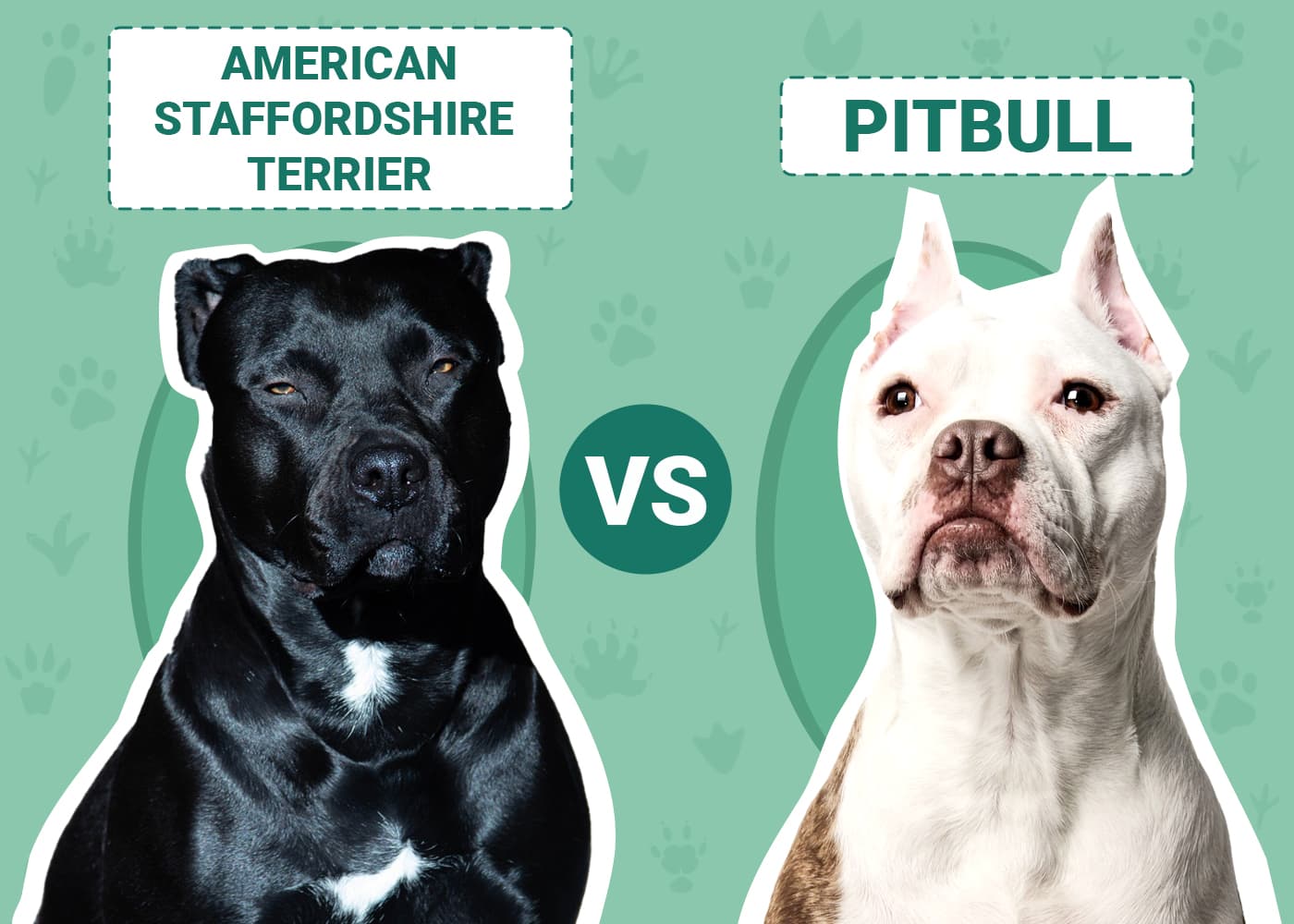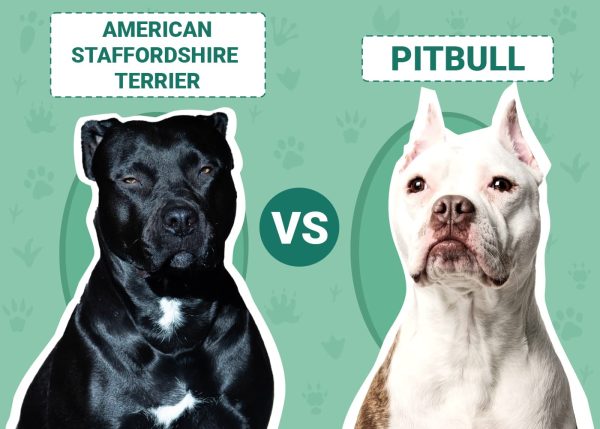Click to Skip Ahead
Whether you’re just curious or actively thinking of adopting a new dog, you’ll want to know everything there is to know about the best dog breeds. The dogs we’re talking about here often get confused with each other—but in reality, they’re pretty different. These breeds may look similar, but there are a few key differences between the American Staffordshire Terrier and the Pit Bull.
Staffies and Bullies, as they’re affectionately known, have an unfair reputation as scary, aggressive dogs. In reality, both of these dog breeds are smart, loyal family animals with boundless energy. To find out if you’re up to the challenge of entertaining these fun dogs, keep reading. We’ll cover the differences between these similar dogs, including physical traits, personalities, health conditions, and trainability.
Visual Differences

At a Glance
- Average height (adult): 18–19 inches (male) / 17–18 inches (female)
- Average weight (adult): 55–70 pounds (male) / 40–55 pounds (female)
- Lifespan: 12–16 years
- Exercise: Moderate energy level; 1+ hours of exercise daily
- Grooming needs: Mild; monthly coat grooming
- Family-friendly: Yes; playful and affectionate
- Other pet-friendly: Mostly friendly to other pets; needs some socialization
- Trainability: Easy to train; intelligent
- Average height (adult): 18–20 inches (male) / 17–18 inches (female)
- Average weight (adult): 35–60 pounds (male) / 30–50 pounds (female)
- Lifespan: 12–16 years
- Exercise: Moderate to high energy level; 1.5+ hours of exercise daily
- Grooming needs: Mild; monthly coat grooming
- Family-friendly: Yes; loving, affectionate, and friendly
- Other pet-friendly: No
- Trainability: Easy to train; eager to please and intelligent
American Staffordshire Terrier Overview
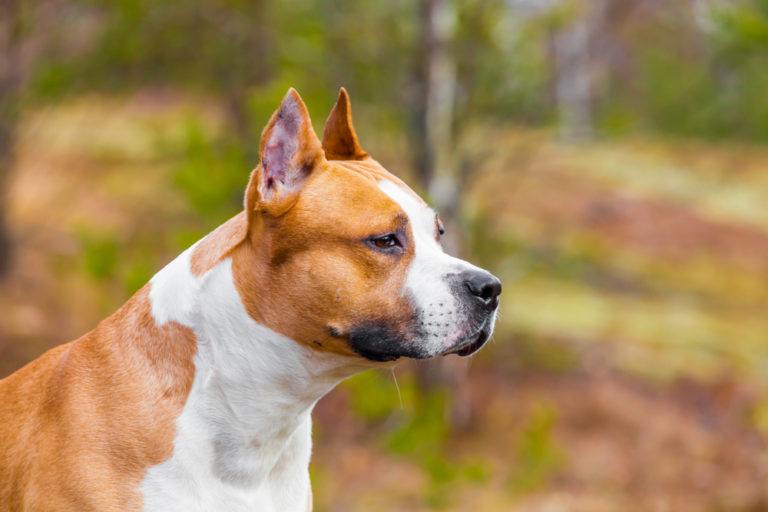
The American Staffordshire Terrier is a medium-sized muscular dog with a playful and loving personality. Due to their stocky build and strong jaws, this breed was often used in illegal dog fighting rings and for bear-baiting, leading people to think they are aggressive by nature. However, this could not be further from the truth: American Staffordshire Terriers are loving, loyal, and friendly.
Personality
If there is one word to summarize the American Staffordshire Terrier’s personality, it would be friendly. This breed is affectionate with family members, good with children, and shows friendliness towards strangers. They are protective, which means it is a good idea to socialize your dog early if you want to expand your pet family.
Keep in mind that this breed does like to bark or howl, so if you live close to other people or in a place with noise restrictions, this breed might not be ideal.
Training and Exercise
Since American Staffordshire Terriers are intelligent and eager to please, this breed is one of the easier ones to train. Since they are smart canines, they will often respond better to training that ends with a reward, like a tasty treat. This breed also enjoys daily exercise, like brief walks of 20–30 minutes; this will also help them maintain a healthy weight.
Playing some games like fetch will keep your American Staffordshire Terrier entertained. They have strong jaws, so make sure the toy you both are playing with is durable!
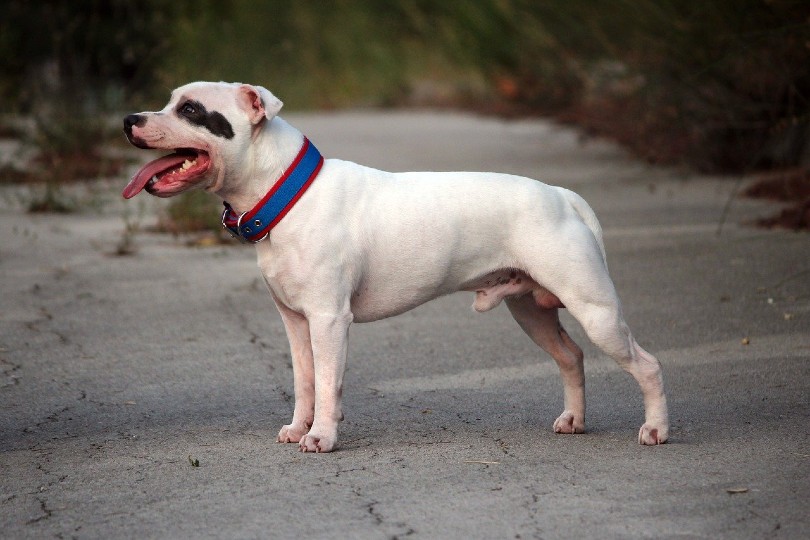
Health & Care
The American Staffordshire Terrier is prone to some minor health issues, such as elbow dysplasia and hypothyroidism, and seldomly, some major issues like progressive retinal atrophy (PRA) and hip dysplasia. Due to their stocky build, they are also prone to weight gain. Exercise and a well-balanced diet will help keep your dog fit and healthy.
American Staffordshire Terriers have a very short coat, meaning they do not need to be groomed that often and do not shed a lot. Giving your pet a monthly grooming session is sufficient to keep them looking clean and maintained.
Suitability
The American Staffordshire Terrier makes an excellent pet for active individuals or families who spend most of their days at home. This breed feels happiest when it is with its owner(s) and can become anxious when left alone for long periods of time. It is not entirely suitable for apartment living.
Due to the tendency for the American Staffordshire Terrier to be a bit noisy, this dog is best suited for areas without noise restrictions.
American Pit Bull Terrier Overview
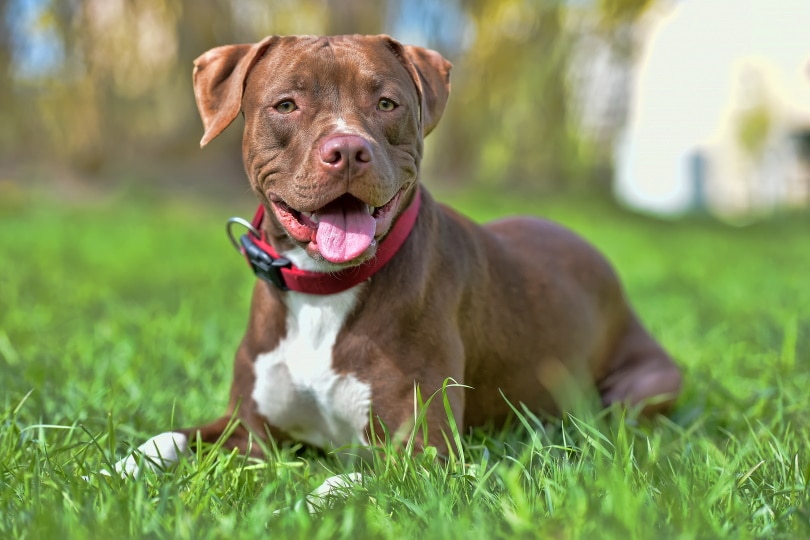
When the name “Pit Bull” is heard, there are many incorrect assumptions made about this gentle canine breed. Often thought of to be overly aggressive and dangerous, these dogs are given a bad reputation. But those who believe this are missing out on the joy a Pit Bull can bring to your life.
The American Pit Bull Terrier is incredibly loving to all people. They greatly enjoy the company and make excellent companions.
Personality
The American Pit Bull Terrier can easily be a part of your family due to its friendly and engaging nature with adults and children. They are willing to shower you with affection on a daily basis. Because they love attention, Pit Bulls do not thrive when they are left alone for most of the day. This can make them anxious, chewing on items in the home. A Pit Bull is happiest knowing its family is nearby.
Despite being wonderful companions to people, Pit Bulls could be aggressive with other dogs if not socialized when they are puppies. When outside in public spaces, Pit Bulls need to be kept on a leash to avoid issues with unfamiliar dogs. However, all American Pit Bull Terriers can be socialized to be friendly with other dogs. It just takes training and persistence.
Training and Exercise
The first thing people notice about the American Pit Bull Terrier is its muscular stature and strong jaw. This means that Pit Bulls love to play tug-o-war with sturdy toys that will not get destroyed easily. They also love exercise! In addition to playing with them indoors, going on daily walks will help your Pit Bull feel loved while maintaining a proper and healthy weight.
Pit Bulls are playful! When not given proper exercise, these dogs might chew up items around your home to release pent-up energy.
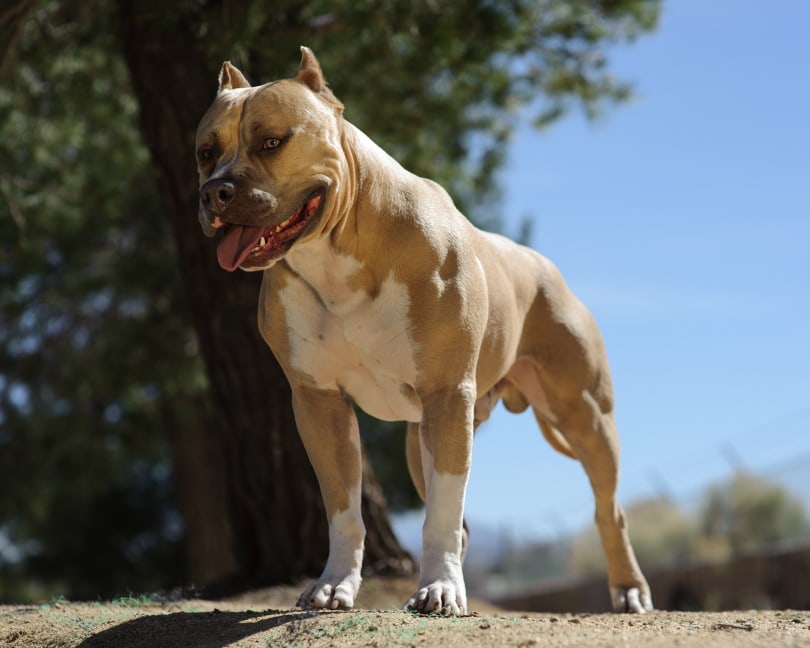
Health & Care
Overall, the American Pit Bull Terrier is a hardy canine. They do have some potential genetic conditions to be aware of, such as hip dysplasia and kneecap dislocation. This breed can also suffer from mild skin issues, like mange.
The American Pit Bull Terrier has a short coat that requires little grooming to keep it clean. They can shed, though. Brushing them or wiping them gently with a wet cloth will help reduce the unwanted dog hair around your home.
Suitability
American Pit Bull Terriers are best suited with an individual or family without other pets who have plenty of time during the day to give attention to them. While Pit Bulls can adapt to apartment living, it is best not to leave them alone for very long periods of time.
This dog makes an excellent pet for someone who has the time to give them the affection they need.
Comparing the Staffordshire and Pit Bull
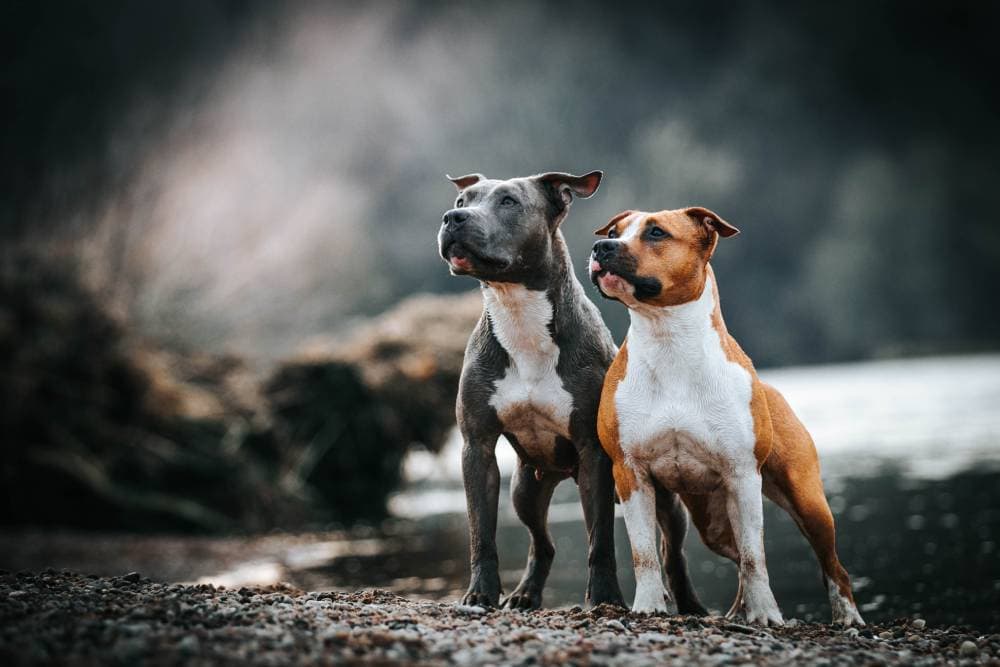
Size and Physical Traits
There is not too much difference in terms of height between these two terrier breeds. In addition, both terrier breeds weigh close to the same, on average. Both have similar coats—short, shiny hair with no undercoat. The Staffordshire and Pit Bull both have muscular physiques and strong jaws.
Overall Personality
While both breeds have the reputation of being aggressive towards people, in both breeds, this is false. The American Pit Bull Terrier is known to be more affectionate and friendly towards all people when compared to the American Staffordshire. However, the Staffordshire is still a very friendly and warm dog. One major difference between the two breeds is that the Pit Bull is more likely to be aggressive towards other dogs.
Both breeds will benefit from early socialization, but this is extra important for Pit Bulls. Each breed needs daily exercise as well as durable chew toys to keep them entertained.
Health and Life Expectancy
Both breeds have a similar life expectancy of between 12–16 years. Due to their build, both are prone to weight gain without proper diet and exercise. In terms of health problems, they are prone to similar ones, like hip dysplasia; however, Pit Bulls are more prone to skin irritations.
Which Breed Is Right for You?
For many people, it can be difficult to tell the difference between an American Staffordshire Terrier and an American Pit Bull Terrier. While there are some subtle physical differences between the two breeds, it is important to know how you can ensure the dog thrives. Do you have another pet? Then a Pit Bull might not be the best decision. Do you live in an apartment or have neighbors close by? The Staffordshire will not be ideal. Are you out of your home for most of the day? Neither dog fits your lifestyle.
Whichever breed of dog you feel is calling your name, know that both breeds are incredibly lovable, friendly, and need attention from their owner. The Staffordshire or the Pit Bull will be a lifelong companion.
Related Reads:
- Pitbull vs Dogo Argentino: The Differences (With Pictures)
- Akita vs. Pitbull: The Differences (With Pictures)
Featured Image Credit: Eve Photography, Shutterstock

